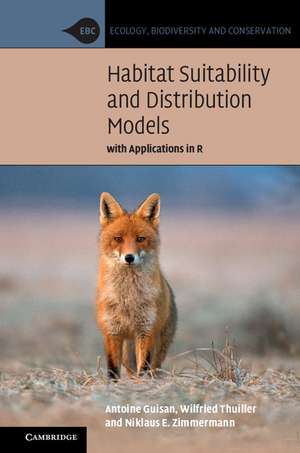Habitat Suitability and Distribution Models: With Applications in R: Ecology, Biodiversity and Conservation
Autor Antoine Guisan, Wilfried Thuiller, Niklaus E. Zimmermannen Limba Engleză Hardback – 13 sep 2017
| Toate formatele și edițiile | Preț | Express |
|---|---|---|
| Paperback (1) | 367.05 lei 6-8 săpt. | |
| Cambridge University Press – 13 sep 2017 | 367.05 lei 6-8 săpt. | |
| Hardback (1) | 724.84 lei 6-8 săpt. | |
| Cambridge University Press – 13 sep 2017 | 724.84 lei 6-8 săpt. |
Din seria Ecology, Biodiversity and Conservation
-
 Preț: 349.59 lei
Preț: 349.59 lei -
 Preț: 276.13 lei
Preț: 276.13 lei -
 Preț: 230.82 lei
Preț: 230.82 lei -
 Preț: 307.24 lei
Preț: 307.24 lei -
 Preț: 356.75 lei
Preț: 356.75 lei -
 Preț: 274.22 lei
Preț: 274.22 lei -
 Preț: 303.90 lei
Preț: 303.90 lei -
 Preț: 351.53 lei
Preț: 351.53 lei -
 Preț: 305.81 lei
Preț: 305.81 lei -
 Preț: 320.13 lei
Preț: 320.13 lei -
 Preț: 355.36 lei
Preț: 355.36 lei -
 Preț: 278.29 lei
Preț: 278.29 lei -
 Preț: 353.48 lei
Preț: 353.48 lei -
 Preț: 328.88 lei
Preț: 328.88 lei -
 Preț: 311.14 lei
Preț: 311.14 lei -
 Preț: 387.22 lei
Preț: 387.22 lei - 11%
 Preț: 451.52 lei
Preț: 451.52 lei - 8%
 Preț: 530.72 lei
Preț: 530.72 lei -
 Preț: 314.82 lei
Preț: 314.82 lei -
 Preț: 306.10 lei
Preț: 306.10 lei -
 Preț: 471.17 lei
Preț: 471.17 lei -
 Preț: 466.38 lei
Preț: 466.38 lei -
 Preț: 402.68 lei
Preț: 402.68 lei - 14%
 Preț: 981.14 lei
Preț: 981.14 lei -
 Preț: 454.76 lei
Preț: 454.76 lei - 11%
 Preț: 565.77 lei
Preț: 565.77 lei - 14%
 Preț: 709.39 lei
Preț: 709.39 lei -
 Preț: 441.83 lei
Preț: 441.83 lei - 14%
 Preț: 929.04 lei
Preț: 929.04 lei - 11%
 Preț: 477.70 lei
Preț: 477.70 lei - 14%
 Preț: 701.48 lei
Preț: 701.48 lei - 14%
 Preț: 1013.18 lei
Preț: 1013.18 lei
Preț: 724.84 lei
Preț vechi: 842.84 lei
-14% Nou
Puncte Express: 1087
Preț estimativ în valută:
138.69€ • 144.82$ • 114.53£
138.69€ • 144.82$ • 114.53£
Carte tipărită la comandă
Livrare economică 16-30 aprilie
Preluare comenzi: 021 569.72.76
Specificații
ISBN-13: 9780521765138
ISBN-10: 0521765137
Pagini: 478
Ilustrații: 133 b/w illus. 8 tables
Dimensiuni: 156 x 235 x 26 mm
Greutate: 0.38 kg
Editura: Cambridge University Press
Colecția Cambridge University Press
Seria Ecology, Biodiversity and Conservation
Locul publicării:Cambridge, United Kingdom
ISBN-10: 0521765137
Pagini: 478
Ilustrații: 133 b/w illus. 8 tables
Dimensiuni: 156 x 235 x 26 mm
Greutate: 0.38 kg
Editura: Cambridge University Press
Colecția Cambridge University Press
Seria Ecology, Biodiversity and Conservation
Locul publicării:Cambridge, United Kingdom
Cuprins
Foreword; Preface; Acknowledgements; Authors' contributions; Introduction; 1. General content of the book; Part I. Overview, Principles, Theory and Assumptions behind Habitat Suitability Modeling: 2. Overview of the HSM modeling procedure; 3. What drives species distributions?; 4. From niche to distribution: basic modeling principles and applications; 5. Assumptions behind HSMs; Part II. Data Acquisition, Sampling Design and Spatial Scales: 6. Environmental predictors – issues of processing and selection; 7. Species data – issues of acquisition and design; 8. Ecological scales – issues of resolution and extent; Part III. Modeling Approaches and Model Calibration: 9. Envelopes and distance-based approaches; 10. Regression-based approaches; 11. Classification approaches and machine learning systems; 12. Boosting and bagging approaches; 13. Maximum Entropy; 14. Ensemble modeling and modeling averaging; Part IV. Evaluating Models: Errors and Uncertainty: 15. Measuring model accuracy: which metrics to use?; 16. Assessing model performance: which data to use?; Part V. Predictions in Space and Time: 17. Projecting models in space and time; Part VI. Data and Tools Used in this Book, with Developed Case Studies: 18. Datasets and tools used for the examples in this book; 19. The biomod2 modeling package examples; Part VII. Conclusions and Future Perspectives: 20. Conclusions and future perspectives in habitat suitability modeling; Glossary and definitions of terms and concepts; References; Index.
Notă biografică
Descriere
This book introduces key stages of niche-based habitat suitability model building, evaluation and prediction, featuring examples using R.
